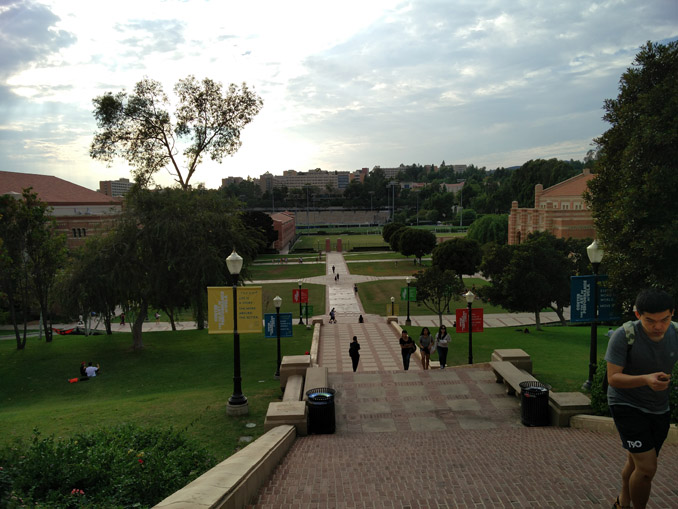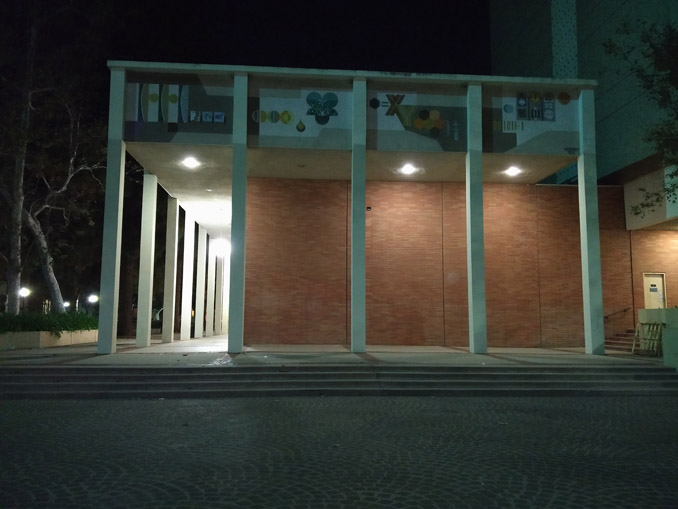The OnePlus 2 Review
by Brandon Chester on December 14, 2015 8:00 AM EST- Posted in
- Smartphones
- Mobile
- OnePlus
- OnePlus 2
Camera Architecture
When the OnePlus One was released one of its most notable features was its camera. At its price, being able to include Sony's IMX214 camera sensor was quite notable. This time around OnePlus is playing in a higher price bracket, and the stakes have been raised due to greater competition. With that being said, the camera is definitely one of the areas I see executed poorly on many non-flagship phones, either due to a poor camera sensor, or more frequently, a poor ISP and inadequate image processing.
| OnePlus One | OnePlus 2 | |
| Front Camera Resolution | 5MP | |
| Front Camera Sensor | Omnivision OV5648 (1/4", 1.4µm) |
|
| Front Camera Aperture | f/2.0 | f/2.0 |
| Rear Camera Resolution | 13MP | |
| Rear Camera Sensor | Sony IMX214 (1/3.06") |
Omnivision OV13860 (1/2.6") |
| Rear Camera Focal Length | 28mm eff | |
| Rear Camera Aperture | f/2.0 | |
The OnePlus 2 retains the OV5648 front-facing camera from the OnePlus One, along with the same lens arrangement. The rear camera now uses an OmniVision sensor as well, which is a departure from the Sony sensor used on the OnePlus One. While some may see this as a downgrade due to Sony's reputation as a great camera sensor manufacturer, I don't think there's any inherent downgrade in moving to an OmniVision sensor. On top of that, we're actually talking about an increase in sensor size from a 1/3.06" format to a 1/2.6" format, which represents a move from 1.12 to 1.3 micron pixels. These aren't as large as those found in a device like the Nexus 5X, but they're larger than the standard 1.12 micron pixels used in the sensors for most flagship smartphones. OnePlus's decision represents another OEM deciding to increase pixel size to improve sensitivity rather than increasing spatial resolution.
Still Image Testing
Due to some less than optimal weather in my area I'll be using the photo comparisons that Josh has taken for his reviews when evaluating the OnePlus 2. In a way this is good, as it means that the OnePlus One is available for comparison, which is a very relevant topic in this circumstance due to its issues with image processing. However, it does mean that the Nexus 5X isn't available in the comparison, which is an unfortunate but worthwhile compromise in this case.
To begin, I'll start with discussing the image quality when taking photos in the daylight with the OnePlus 2, followed by looking at how it fares during the night.
| Daytime Photography |
When taking photos during the day, the OnePlus 2 exhibits some improvements over its predecessor, but some regressions as well. The OnePlus One had some notorious processing issues, and one of the most prominent was how chroma noise would be plainly visible even in scenes with ample lighting. In this scene one can notice that the noise across the frame has been reduced dramatically. While this is good in a sense, OnePlus seems to have gone a bit overboard. Looking at the grass and the textures of the walkway one can see that the amount of detail is reduced compared to the OnePlus One. This is easily visible in the grass, where the heavy noise reduction has turned it into a featureless green smear.
As far as sharpness goes, the OnePlus 2 is definitely an improvement over the OnePlus One in the areas where noise reduction hasn't caused havoc. Examining the tree in the top left of the frame makes this quite apparent, with the OnePlus 2 maintaining the sharpness of the individual branches, and the OnePlus One producing a much fuzzier rendition.
Overall, if I had to choose between the OnePlus One and the OnePlus 2 as a day time camera, I would probably go with the OnePlus 2 simply due to the fact that the chroma noise in the photos taken with the OnePlus One is incredibly distracting. OnePlus definitely has room to improve their processing by toning down the noise reduction a bit in order to better preserve the detail of leafy foliage and grass. I think that phones like the Nexus 5X that offer better image quality at this price point, but they come with their own caveats as well such as having to use HDR+ mode on the Nexus 5X which greatly lengthens the capture time.
| Low Light Scene 2 |
In night time photography the OnePlus 2 makes further gains over its predecessor. When looking at the shot it's immediately obvious how much more detail is retained on the OnePlus 2, and there's none of the distracting chroma noise and smearing that exists in the OnePlus One's photo. When comparing the OnePlus 2 to other smartphones it becomes clear that it's not as good as the latest flagship devices like the Galaxy Note5 and the LG G4, but it still ends up being fairly good, and bests smartphones like the iPhone 6.
It's clear that OnePlus was aware of the problems with image processing on the OnePlus One, and the quality of photos taken with the OnePlus 2 is much better. They definitely have room to improve by toning down noise reduction which would allow them to preserve more fine details in foliage, but as it is now the camera still outputs fairly good images for a phone of this price.
Video Recording
The OnePlus 2 offers three modes for recording video. There's a 720p mode, a 1080p mode, and a UHD mode. I'll just be focusing on the latter two, as at this point almost no smartphones offer any additional benefits by recording in their 720p mode other than smaller file sizes in return for lower quality.
When recording UHD video, the OnePlus 2 puts up a notification letting you know that the capture time is limited to ten minutes. I'm glad that OnePlus, like most vendors, has thought to do this so you don't run into situations where your video stops recording without you even knowing like can happen with the new Nexus phones. As for the video itself, it's a 42Mbps 3840x2160 file recorded at 30fps, with a 96Kbps stereo audio stream. The video is encoded using the H.264 Baseline profile, which makes the OnePlus 2 another device in a trend of Android phones that use an H.264 profile that can't take advantage of space-saving features like B-frames and CABAC which would allow for smaller files or higher bitrates at the same file size.
The video is adequate from a pure visual quality perspective, but the visibly changing FOV and jerky motion caused by the use of OIS for stabilization is very difficult to overlook. It surprises me that almost every smartphone manufacturer continues to implement OIS video stabilization in such a simplistic manner, as it makes the video quite unpleasant to watch.
As for the 1080p video, it's a 20Mbps H.264 baseline stream with the same audio encoding as the UHD footage. Since you're not really gaining anything as far as stabilization goes due to the jerkiness of the footage when the OIS resets, I would stick to the UHD recording mode unless you need to record footage longer than 10 minutes in length, or if you want to save space. I suspect that most buyers will be purchasing the 64GB model of the OnePlus 2 where this won't pose a problem anyway.












132 Comments
View All Comments
aenews - Tuesday, December 15, 2015 - link
The author mentions his dislike of the "back cover material" many times throughout the article and fails to see the point of a removable back plate. He clearly does not realize StyleSwap™ exists and is a major selling point of the phone.He also doesn't seem to realize there's a color slider in settings that adjusts the tint of the screen. Pulling the slider all the way to the right would yield more color-accurate displays for most OnePlus 2's. He should have tested further with the spectrophotometer IMO. Everyone has his own temperature preferences in regards to the display.
Brandon Chester - Thursday, December 17, 2015 - link
I'm not sure how you can assert that the slider would have an impact without having measured a difference. I did do that, and the difference is insignificant. It's just not a good display.Also, no company offering heavy phone customization is doing very well financially in the smartphone market, so something like StyleSwap is clearly not a major selling point for most consumers.
MarcSP - Tuesday, December 15, 2015 - link
Random Android device: ReviewFlagship of the third mobile platform: Nope!
MarcSP - Tuesday, December 15, 2015 - link
That's really weird. In any case, you could have explained that from the begining.Still, thanks for the reply :-). And ignore another message I posted later. I thought the first one had failed.
vishnumrao - Tuesday, December 15, 2015 - link
Well written and informative review.This review is giving me a sever bout of "buyer's remorse". I was deliberating with myself, between the Nexus 6P and the OnePlus Two. I jumped the gun, when I got an invite. I bought it based on the "on paper" specs and the rave reviews of the predecessor.
Right off, I felt the UI sluggish. Ever so slightly! Some hesitation to move! I installed Cpu Spy app and I started noticing that the processors were maxed out at 1555 (1.56 GHz on the A53). Even when playing games, I never saw CPU states higher than that.
I was surprised by the color accuracy assessments. I never noticed it. Maybe I am not very color sensitive.
The hope is that CM 13 will officially support OnePlus Two phones. That should fix some of the issues on the CPU usage. Oxygen OS is buggy too! An example of a bug I found: https://forums.oneplus.net/threads/cpu-usage-durin...
No official acknowledgement of the issue and no fix either.
I wish I had never got that invite to buy!
SydneyBlue120d - Tuesday, December 15, 2015 - link
Still no HEVC encoding from the Snapdragon 810, do You know if there is some hack to shot videos in HEVC? Thanks a lot.dexterkarthik - Tuesday, December 15, 2015 - link
finally - this review helped in ruling out OP2 and wait for the SD820 to come and then zero in on the Nexus 6P is on sale!!vladx - Tuesday, December 15, 2015 - link
Wtf are you putting S808 in the same sentence with S810? S808 does very well, as shown by the LG G4 score in the tests. Even beats S6 in some.Lbhati - Tuesday, December 15, 2015 - link
@Brandon oneplus one never had ois. Please correct that.albireox - Wednesday, December 16, 2015 - link
Is the reviewer actually aware that the much highlighted Oneplus One display had a yellow tint on a great number of batches sold by Oneplus? So is then relevant that the OnePlus One had better calibrated screen ?On the other hand, you seem to miss that Oneplus 2 has dual SIM functionality that isn't present in a lot of phones that you regard (and recommend) as better purchases?